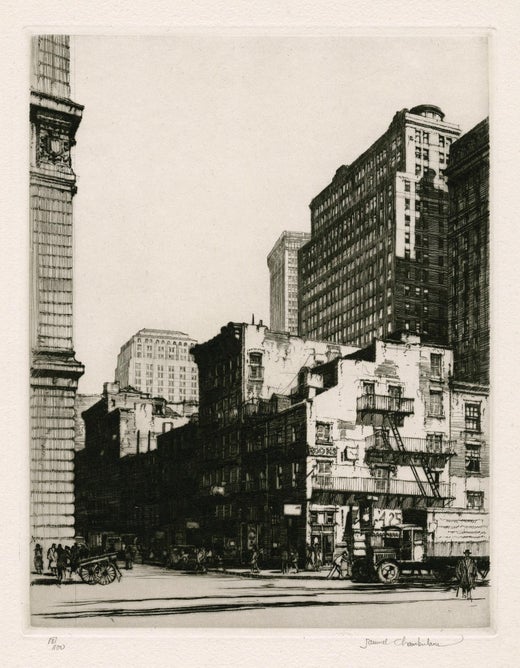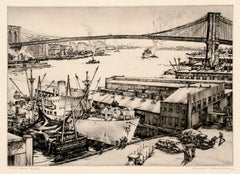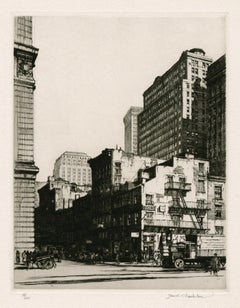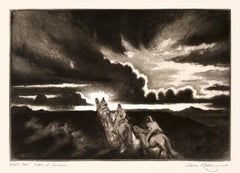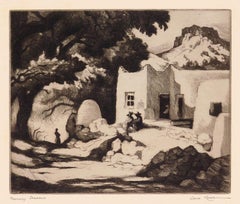Want more images or videos?
Request additional images or videos from the seller
1 of 3
Samuel Chamberlain'Soaring Steel' — Vintage Chicago Cityscape1929
1929
Price:$1,700
About the Item
- Creator:Samuel Chamberlain (1895-1975, American)
- Creation Year:1929
- Dimensions:Height: 12.25 in (31.12 cm)Width: 9.5 in (24.13 cm)
- Medium:
- Movement & Style:
- Period:
- Condition:
- Gallery Location:Myrtle Beach, SC
- Reference Number:Seller: 1033961stDibs: LU532313162142
Samuel Chamberlain
Samuel V. Chamberlain, printmaker, photographer, author, lecturer, and teacher was born in Cresco, Iowa on October 28, 1895. His family moved to Aberdeen, Washington in 1901 and, in 1913, Chamberlain enrolled in the University of Washington in Seattle where he studied architecture under Carl Gould. By 1915, he was enrolled in the School of Architecture of the Massachusetts Institute of Technology in Boston. With the United States' involvement in the First World War, Chamberlain sailed to France where he volunteered in the American Field Service. In 1918, he was transferred to the United States Army to complete his tour of duty. After the war, he returned to Boston and resumed his architectural studies, which he eventually discontinued and tried for a few years to work as a commercial artist. Chamberlain received the American Field Service Scholarship in 1923, which he used to travel in Spain, North Africa, and Italy. In 1924 he was living in Paris and in the spring he studied lithography with Gaston Dorfinant and in the autumn and winter months, he studied etching and drypoint with Edouard Léon. He published his first etching the following year. In 1927, he studied drypoint with Malcolm Osborne at the Royal College of Art in London. He taught part-time at the School of Architecture, University of Michigan, Ann Arbor; and the School of Architecture, Massachusetts Institute of Technology between his travels abroad. Chamberlain eventually settled for a dozen years in France. He authored and sometimes co-authored, with his wife Narcissa, Domestic Architecture of Rural France, Clementine in the Kitchen, New England Rooms 1639-1863, and Charleston Interiors. Chamberlain was a member of the American Academy of Arts and Sciences, the American Institute of Architects, the American Society of the French Legion of Honor, the Boston Camera Club, the Boston Printmakers, the Chicago Society of Etchers, Photographic Society of America, the Print Club of Albany, the Society of American Etchers, and was elected an Academician in the National Academy of Design. His work is represented in the collections of the Smithsonian American Art Museum, the Library of Congress, the Metropolitan Museum of Art, the Philadelphia Museum of Art, the National Academy Museum, the Harvard Art Museums, the Carnegie Museum of Art, the Museum of Fine Arts in Houston, the Museum of Fine Arts Boston, and the Nelson-Atkins Museum of Art. Samuel V. Chamberlain died in Marblehead, Massachusetts on January 10, 1975.
About the Seller
5.0
Recognized Seller
These prestigious sellers are industry leaders and represent the highest echelon for item quality and design.
Platinum Seller
Premium sellers with a 4.7+ rating and 24-hour response times
Established in 1995
1stDibs seller since 2016
325 sales on 1stDibs
Typical response time: 1 hour
Associations
International Fine Print Dealers Association
Authenticity Guarantee
In the unlikely event there’s an issue with an item’s authenticity, contact us within 1 year for a full refund. DetailsMoney-Back Guarantee
If your item is not as described, is damaged in transit, or does not arrive, contact us within 7 days for a full refund. Details24-Hour Cancellation
You have a 24-hour grace period in which to reconsider your purchase, with no questions asked.Vetted Professional Sellers
Our world-class sellers must adhere to strict standards for service and quality, maintaining the integrity of our listings.Price-Match Guarantee
If you find that a seller listed the same item for a lower price elsewhere, we’ll match it.Trusted Global Delivery
Our best-in-class carrier network provides specialized shipping options worldwide, including custom delivery.You May Also Like
Restaurant in Mott Street
By Charles Frederick William Mielatz
Located in New Orleans, LA
The image depicts a restaurant on New York's Mott Street with ornamental iron work on the balconies. There are six figures in the scene in various stages of contrast. Mott Street is considered the unofficial Main Street of New York's Chinatown. Ella Fitzgerald sang it best: “And tell me what street compares with Mott Street in July? Sweet pushcarts gently gliding by.”
CFW Mielatz was an early influence on the drypoints and etchings of Martin Lewis. This piece was created in 1906 and it is signed in pencil. It is part of the collection of New York's Metropolitan Museum of Art
C.F.W. Mielatz
American, 1860-1919
Born in Bredding, Germany in 1864, Mielatz emigrated to the United States as a young boy and studied at the Chicago School of Design. Mostly self-taught, his first prints were large New England landscapes reminiscent of the painter-etcher school of American Art. Around 1890 he started to produce prints of New York City and by the time of his death, the number totaled over ninety images. He was a master technician in the field of etching, reworking many of his plates to get the exact feeling he was seeking. Mielatz was a member of the New York Etching...
Category
Early 20th Century American Modern Landscape Prints
Materials
Drypoint, Etching
$400 Sale Price
27% Off
H 9.88 in W 6.25 in
The Fair
By James Abbott McNeill Whistler
Located in Storrs, CT
The Fair. 1895-96. Lithograph. Way 92, Levy 144, Tedeschi, Stratis and Spink 135 state ii. Image 9 1/4 x 6 1/2 (sheet 13 x 9 5/8). A fine impression printed on antique cream-laid paper. Way lists 15-lifetime impressions (Goulding printed...
Category
Late 19th Century American Modern Figurative Prints
Materials
Drypoint, Etching
Cincinnati Union Terminal, Perspective From East
By Louis Conrad Rosenberg
Located in Fairlawn, OH
Cincinnati Union Terminal, Perspective From East
Drypoint, 1930-1931
Signed in pencil lower right (see photo)
Initialed and dated the the plate above the pencil signature
From: Cincinnati Series (8 Plates), this No. 2
Edition: 155, completed May 4, 1931
Delivered to Fellheimer & Wagner, 1931
Louis Conrad Rosenberg
1890-1983
An American architectural etcher and engraver of the 1920's and 1930's era, Louis Conrad Rosenberg first studied at the Massachusetts Institute of Technology...
Category
1930s American Modern Landscape Prints
Materials
Drypoint
Ancient Landscape II (Ancient City)
By Louise Nevelson
Located in Fairlawn, OH
Ancient Landscape II (Ancient City)
Etching and drypoint, 1953-55
Signed and titled in pencil by the artist (see photos)
Annotated: "E130 A/1" in pencil lower right
Estate stamp vers...
Category
1950s American Modern Landscape Prints
Materials
Drypoint
Ontario St. Grading and Temporary Ramps
By Louis Conrad Rosenberg
Located in Fairlawn, OH
Ontario St. Grading and Temporary Ramps
Drypoint, August 1929
Signed in pencil lower right (see photo)
From: The Cleveland Set (23 plates), this being No. 13
Edition: Small
A brilliant example of American industrial art. A wonderful, rich impression, with lots of burr and contrasts.
Louis Conrad Rosenberg
1890-1983
An American architectural etcher and engraver of the 1920's and 1930's era, Louis Conrad Rosenberg first studied at the Massachusetts Institute of Technology. He then enrolled at the Royal College of Art, London, to study etching techniques under Malcolm Osborne...
Category
1920s American Modern Landscape Prints
Materials
Drypoint
Western Hills Viaduct Under Construction
By Louis Conrad Rosenberg
Located in Fairlawn, OH
Western Hills Viaduct Under Construction
Drypoint, June 1931
Signed in pencil lower right (see photo)
Initialed and dated in the plate lower right above pencil signature (see photo)
From: Cincinnati Series, 1930-1931, 8 plates, this No. 5
Small edition, not specified
From Greenfield Hill
Condition: Excellent
Image/Plate size: 8 1/2 x 15 1/4 inches
Sheet size: 11 1/4 x 18 1/2 inches
Louis Conrad Rosenberg
1890-1983
An American architectural etcher...
Category
1930s American Modern Landscape Prints
Materials
Drypoint
Victor DeWilde, The Anchor (San Francisco), 1930s
Located in New York, NY
Born in Tamines, Belgium, Victor DeWilde (1903-1977) settled in San Francisco around 1925. He studied at the California School of Fine Arts, SF, and California College of Arts & Crafts, Oakland. During the 1930s he taught at Commerce Evening High School and then worked on the WPA Art Education Program. His colleagues included Robert McChesney, Otis Oldfield, George Post...
Category
1930s American Modern Landscape Prints
Materials
Drypoint
Samuel Chamberlain, The Public Gaol, Williamsburg (Virginia)
By Samuel Chamberlain
Located in New York, NY
Samuel Chamberlain was a superb draftsman and his architectural images are often very complex. This image is, by contrast, quiet and understated: serene to the point of lonely. It's ...
Category
1930s American Modern Figurative Prints
Materials
Drypoint
Armin Landeck, Tenement Walls
By Armin Landeck
Located in New York, NY
The reference number on this work is Kraeft 88. It's from an edition of 100 and is signed, dated, and numbered, in pencil.
Always an intaglio printmaker, Landeck switched from a mor...
Category
Mid-20th Century American Modern Figurative Prints
Materials
Drypoint
A. Schultz, Riders in Central Park (New York City)
Located in New York, NY
Such an innovative image on the classic 'Riders in the Park' theme! Further, the use of drypoint and the rather direct -- even aggressive -- drawing style, bring it into the German E...
Category
1930s American Modern Landscape Prints
Materials
Drypoint
More From This Seller
View All'The East River', Brooklyn Bridge — Mid-Century Realism, New York City
By Lawrence Wilbur
Located in Myrtle Beach, SC
Lawrence Nelson Wilbur (1897-1988), 'The East River', drypoint, edition 65, 1946. Signed, titled, and annotated 'A. Jones Proof 1946' in pencil. Signed and dated in the plate, lower ...
Category
1940s American Modern Landscape Prints
Materials
Drypoint
'Manhattan Old and New' — Vintage New York Cityscape
By Samuel Chamberlain
Located in Myrtle Beach, SC
Samuel Chamberlain, 'Manhattan Old and New', drypoint, 1929, edition 100, Chamberlain and Kingsland 81. Signed, titled, and numbered '81/100' in pencil. Titled and annotated '30.00' in pencil, in the artist's hand, bottom margin. Matted to museum standards, unframed.
A superb, finely-detailed impression, with selectively wiped plate tone, on heavy Rives cream wove paper; full margins (1 1/2 to 2 1/4 inches), in excellent condition.
The subject of the print is the lower Manhattan cityscape just before the Depression.
Image size 8 3/4 x 6 13/16 inches (222 x 173 mm); sheet size 12 3/4 x 10 inches (324 x 254 mm).
Impressions of this work are held in the collections of the National Gallery of Art and the Zimmerli Art Museum.
ABOUT THE ARTIST
'There is something about the atmospheric vibrancy of an etching which imparts a peculiar and irresistible life to architectural drawing...A copper plate offers receptive ground to the meticulously detailed drawing which so often appeals to the architect'. —Samuel Chamberlain, from the Catalogue Raisonné of his prints.
Samuel V. Chamberlain (1896 - 1975), printmaker, photographer, author, and teacher, was born in Iowa. His family moved to Aberdeen, Washington in 1901, and in 1913, Chamberlain enrolled in the University of Washington in Seattle, where he studied architecture under Carl Gould. By 1915, he was enrolled in the School of Architecture of the Massachusetts Institute of Technology in Boston. With the United States' involvement in the First World War, Chamberlain sailed to France, where he volunteered in the American Field Service. In 1918, he was transferred to the United States Army to complete his tour of duty. After the war, he returned to Boston and resumed his architectural studies, which he eventually discontinued, working for a few years as a commercial artist.
Chamberlain received the American Field Service Scholarship in 1923, which he used to travel to Spain, North Africa, and Italy. In 1924 he was living in Paris, where he studied lithography with Gaston Dorfinant and etching and drypoint with Edouard Léon, publishing his first etching the following year. In 1927, he studied drypoint with Malcolm Osborne...
Category
1920s American Modern Landscape Prints
Materials
Drypoint
'Riders at Sundown' — Mid-Century Southwest Regionalism
By Gene Kloss
Located in Myrtle Beach, SC
'Riders at Sundown', aquatint and drypoint, edition 75, 1953, Kloss 451. Signed, titled, and annotated 'Artist's Proof' in pencil. A superb, richly-inked, atmospheric impression, in ...
Category
1950s American Modern Landscape Prints
Materials
Drypoint, Aquatint
'Noonday Shadows' — Mid-Century Southwest Regionalism
By Gene Kloss
Located in Myrtle Beach, SC
'Noonday Shadows', etching and drypoint, edition 75, 1941, Kloss 376. Signed, and titled in pencil. A superb, richly inked impression, in warm black ink, on buff wove paper, in excel...
Category
1950s American Modern Landscape Prints
Materials
Drypoint, Etching
Tranquil Harbor (Gloucester, Massachusetts) — 1950s Cape Ann Regionalism
By Lawrence Wilbur
Located in Myrtle Beach, SC
Lawrence Nelson Wilbur (1897-1988), 'Tranquil Harbor' (Gloucester, Massachusetts), wood engraving, edition 55, 1958. Signed in pencil, and signe...
Category
1950s American Modern Landscape Prints
Materials
Woodcut
'Financial District', New York City — American Modernism
By Howard Norton Cook
Located in Myrtle Beach, SC
Howard Cook, 'Financial District', lithograph, 1931, edition 75, Duffy 155. A fine, richly-inked impression, on cream wove paper, the full sheet with wide margins (2 3/4 to 5 5/8 inches), in excellent condition. Image size 13 5/16 x 10 3/8 inches (338 x 264 mm); sheet size 23 x 16 inches (584 x 406 mm). Matted to museum standards, unframed.
Literature: 'American Master Prints from the Betty and Douglas Duffy Collection', the Trust for Museum Exhibitions, Washington, D.C., 1987.
Collections: Crystal Bridges Museum of American Art, Library of Congress, Metropolitan Museum of Art, Philadelphia Museum of Art, Smithsonian American Art Museum.
ABOUT THE ARTIST
Howard Norton Cook (1901-1980) was one of the best-known of the second generation of artists who moved to Taos. A native of Massachusetts, he studied at the Art Students League in New York City and at the Woodstock Art Colony. Beginning his association with Taos in 1926, he became a resident of the community in the 1930s. During his career, he received two Guggenheim Fellowships and was elected an Academician in the National Academy of Design. He earned a national reputation as a painter, muralist, and printmaker.
Cook’s work in the print mediums received acclaim early in his career with one-person exhibitions at the Denver Art Museum (1927) and the Museum of New Mexico (1928). He received numerous honors and awards over the years, including selection in best-of-the-year exhibitions sponsored by the American Institute of Graphics Arts, the Brooklyn Museum, the Society of American Etchers, and the Philadelphia Print Club. His first Guggenheim Fellowship took him to Taxco, Mexico in 1932 and 1933; his second in the following year enabled him to travel through the American South and Southwest.
Cook painted murals for the Public Works of Art Project in 1933 and the Treasury Departments Art Program in 1935. The latter project, completed in Pittsburgh, received a Gold Medal from the Architectural League of New York. One of his most acclaimed commissions was a mural in the San Antonio Post Office in 1937.
He and Barbara Latham settled in Talpa, south of Taos, in 1938 and remained there for over three decades. Cook volunteered in World War II as an Artist War Correspondent for the US Navy, where he was deployed in the Pacific. In 1943 he was appointed Leader of a War Art Unit...
Category
1930s American Modern Figurative Prints
Materials
Lithograph
Recently Viewed
View AllMore Ways To Browse
James Swann
Jules Cavailles On Sale
Lichtenstein Haystack
Lightning Plane
Michael Schofield On Sale
Monet Signed Prints
Palestine Wall Art
Queensboro Bridge
R Marsh
Richard Devonshire
Rowland Langmaid
Sncf Dali
Spring Song Vintage Print
Thomas Moran Etching
Used Porta John
Valerie Thornton
Vintage United Airlines Travel Posters
William Stafford
